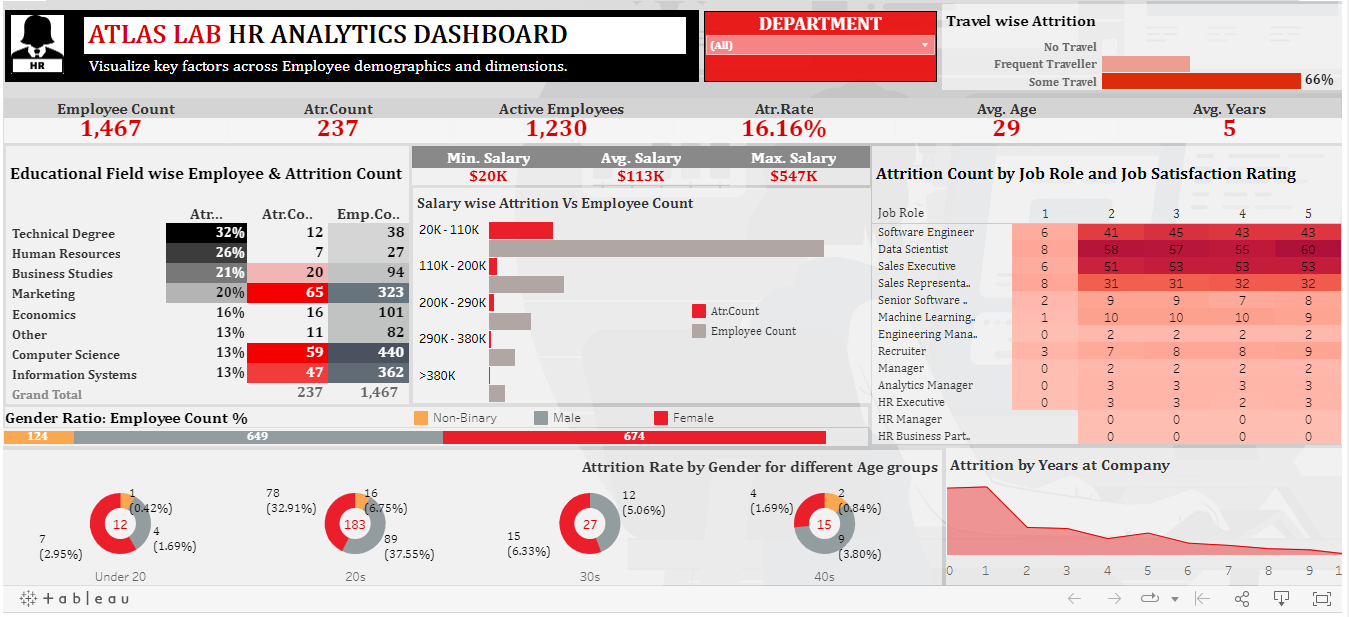HR Analytics Dashboard
 Preeyal Jyotika
Preeyal Jyotika
Objective:
The project aims to analyze and visualize employee attrition within the company and identify factors that contribute to attrition.
Data Analysis:
Conducted thorough exploratory data analysis to understand attrition patterns, salary disparities, educational backgrounds, age groups, experience levels, and the impact of business travel on attrition.

Developed a comprehensive dashboard using Tableau Public to present the analysis findings visually and intuitively.

Summary

Determined that the overall attrition rate in the company is 16.16%, with the highest attrition observed in the Sales department (20.72%), followed by Human Resources (19.05%), and the lowest in the Technology department (13.85%).

Identified a significant gap between minimum and maximum salaries, with the majority of employees falling within the 20k-110k salary range. This salary range also experienced the highest attrition.

Discovered that data scientists, software engineers, sales executives, and sales representatives had the highest attrition rates, indicating dissatisfaction within these specific roles.

Noted that employees with technical degrees had the highest attrition rate (32%), followed by marketing (20%). HR employees with an HR background had a 26% attrition rate, and business studies employees in the Technology department had a 21% attrition rate.

Found that a significant proportion of attrition occurred in the younger age group (20s), with employees in the early years of their careers (0-5 years) showing higher attrition rates.

Uncovered a correlation between business travel and attrition, with employees who had some travel having the highest attrition rate (66%), followed by frequent travelers (29%).
Recommendations:

Based on the analysis, provided recommendations for the organization to take action and implement strategies to retain more employees, focusing on areas such as salary disparities, job satisfaction, and addressing challenges related to business travel.
Implementing measures to support and engage their employees can help improve retention and foster long-term commitment to the organization to the younger age group (the 20s) and employees with limited years of experience, as they show higher attrition rates.
The sales team exhibits the highest attrition rate among all departments, indicating a concerning trend. Further analysis reveals that employees with technical degrees and marketing backgrounds, primarily within the sales team, are more likely to leave the company. In particular, job roles such as sales executives and sales representatives have a significant count of attrition.
This suggests that there may be specific issues within the sales department that contribute to dissatisfaction and turnover.
Conclusion:

This blog involves the project overview of visualization, and interpretation of employee attrition data, highlighting key insights and providing actionable recommendations to help the organization address attrition and improve employee retention.
Limitations

Department-Specific Analysis: The dashboard focuses on three departments (Sales, Technology, and Human Resources), which may not represent the entire organization.
Self-Learning Approach: Since this project is self-learned, there might be limitations in terms of industry standards, best practices, and advanced analytical techniques

PS :)
In the upcoming blogs, I will delve into the individual visualizations used in the dashboard, offering detailed insights and analysis. Stay tuned for more exciting content to come!
Subscribe to my newsletter
Read articles from Preeyal Jyotika directly inside your inbox. Subscribe to the newsletter, and don't miss out.
Written by

Preeyal Jyotika
Preeyal Jyotika
Data Analyst @United Airlines✈️